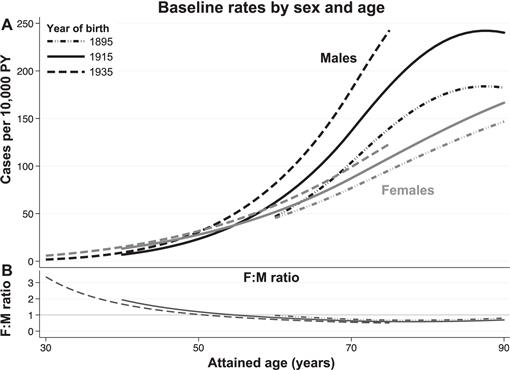KAJJAK: Nejlepsii je o tematu si nenco zjistit. Dohledat si vedecke publikace, statistiky, nez jen si neco spekulovat.
Zacal bych treba tim, co ti tu linkujou.
Konkretne co se tyce rakoviny ta Dr. Devra Davis hovori tom, jak je to komplikovana problematika.
Upozornuje, ze po explozi atomove bomby v Hirosime, se nejvice rakoviny objevilo az po 40 letech.
Dohledal jsem si nejaka data
https://bioone.org/journals/radiation-research/volume-187/issue-5/RR14492.1/Solid-Cancer-Incidence-among-the-Life-Span-Study-of-Atomic/10.1667/RR14492.1.full
Rakovina se rozviji roky.
Upozornuje na mozny problem, ze zvysena incidence rakoviny muze prijiit az po letech, a do te doby nejevit zmenu.
Jak dlouho pouzivame mobily? Ja cca 20 let.
Dalsim faktorem je, ze se postupem casu zmenilo uzivani telefonu.
Napriklad zvetsilo mnozstvi casu, ktery clovek stravi s telefonem.
Pribylo do toho pozdeji pak rozsireni Wi-fi, kterymi jsme v poslednich letech skoro vsude obklopeni. To je relativne nova vec.
V dnesni dobe taky s mobily operuji uz i male deti. Nebo tablety, ktere si daji do klina.
Ukazovala i reklamu na iPotty. normalne vyrobili zachudky s drzakem na tablet.
 Amazon.com: Customer reviews: CTA Digital 2-in-1 iPotty with Activity Seat for iPadhttps://www.amazon.com/CTA-Digital-iPotty-Activity-Seat/product-reviews/B00B3G8UGQ
Amazon.com: Customer reviews: CTA Digital 2-in-1 iPotty with Activity Seat for iPadhttps://www.amazon.com/CTA-Digital-iPotty-Activity-Seat/product-reviews/B00B3G8UGQVsechny tyhle zmeny uzivani lze ocekavat, ze se nejspis muzou projevit zas s dalsim zpozdenim. Resp. kumulativni efekt.
Do toho se zavadi 5G, o kterych mame studii nejmin.
Nejvyrazneji se 5G zavadelo v roce 2020 behem COVIDu... v casech zakazu vychazeni se zbesile instalovaly v UK ruzne 5G veze.
Soubeznost s COVIDem znemozni i videt pripadne korelaci zdravotnich problemu, kdyz ted se COVID stal skoro jedinou metrikouo zdravi
U milimetrovych vln lze uvazovat, ze by zmensila vzdalenost od telefonu, kded by to melo primo vyhrivaci efekt, a ani ten by nemel byt jedinou metrikou. Je tam i frekvence, struktura pripadne tech vlnovych patternu, kdyz telefon treba hleda BTS zesili signal, nebo pri hovoru.. kazdopadne tten handshake zname nekdy , kdyz se to nekdy nechtene namontuje do sluchatek nebo repraku to zname modemove chrochtani.
https://twitter.com/zaidzamanhamid/status/1245980680619724801
Spousta profesi byla zakazana kvuli lockdownu, ale technici instalujici 5G veze byli povoleni..... protoze 5G bylo pry potreba, aby se dal resit COVID. Proc by nestacily ty starsi site se nikdo ani vysvetlit nepokusil.
Zavadime tedy v domneni, ze predchozi site 1G, 2G, 3G, 4G, Wifi zadne dopady na zdravi nemely, sit novou, protoze masove lidi neumiiraj.
Misto inttenzivniho vyzkumu se spis setkavame s posmechem, ze je to uplne sabla myslenka, ze by to mohlo jakkoliv skodit. Vzdyt ten vyzareny vykon je prece prilis slaby na to, aby to teoreticky mohlo nekomu uskodit, a protoze tedy vime, ze mobilni site nejsou zdravi skodliive, ani nedelame studie, ktere by to ale i prokazaly na datech. Zvlastni logicka smycka. :)
Ad Smart ciities teda nevim, kdy si vlastne vzal tu souvislost s elektromagnetickym zarenim... ja v tom topicu vnimam hlavne temata jina... IoT, smart semafory, smart meraky.. logistika, finnancni transakce, sledovaci system, AR 3D skenery a samozrejme oblibeny zivot na socialni kredit v mobilni apce.
Mozna neco j ako v te hre Cyberpunk 2077 ... Ja byl vzdycky hodne do sci-fi, ale v poslednich letech zacinam nevnimat tyhle metaverse svety ani augmenty tela nebo mozku jakoo neco neprilis odlisne od "soucasneho mesta".
A jednu takovou Cyberpunk like strukturu uz stavi tusim v Saudske Arabii..
Dlouhou... mega dlouhou linku vysoke steny.. totalni obludnost, i kdyz jiste sci-fi srdcicko trochu povzdechne :)
Saudi Crown Prince: THE LINE vertical design communities to house 9 mln residents | Al Arabiya Englishhttps://english.alarabiya.net/News/gulf/2022/07/26/Crown-Prince-THE-LINE-will-house-9-mln-residents-in-vertical-design-communities
Pri hrani te hry, co jsem o vanocich s nove koupenou 3090 RTX kartou uz musel rozparit, jsem si vsiml, jaky by takovy svet byl cisty peklo. Chladne prostori kovu, betonu, AR reklam, augmentace a dekadence totalnii post modernity.
Zadna priroda, zvirata... jen displaye, hologramy, augmentovana realiita, a velky struktury. Zadne lesy, priroda. Pouze obloha.
Kdysi bych i pro oblibu technologii by me asi i takovy sci-fi lakalo, ale to co uz prislo v soucasne dobe mi ukazuje, jak vlasatne by to totalne vykoreiloo cloveka.
Uz tak dost vykoreneho se soucasnymi jen mobily a Web2.0.. .lidi prevazne zavreny v baracich s mobily, tablety v ruce nebo za kompem. A v okoli aspon 10 wifin od sousedu a vsude po meste.
A ted s 5G kvuli vyssi rychlosti pujde udelat bryle, ktery nebudou potrebovat pocitac... muzou to renderovat v cloudu. Uz pred rokem nejpozdejs byly prototypy AR her, kde ty bryle zakomponuji do sceny vas vlastni dum, a na predmety promitaji augmentovanou realitu. Teda ty bryle uz existujou :)
Diky 5G lze zajistit dostatecnou rychlost, aby to uzivilo. Tohle imho bude mit opravdu masakr dopady na podobu tech smart cities.
Hodne slusne uz je to rozvinute v Cine. Sanitce automaticky nastavuje zelenou na semaforech. Otvirani dveri domu pomoci face scanu.
Future of 5G Ep. 4: Augmented Reality and 5G in Gaming | T-Mobile for Businesshttps://www.t-mobile.com/business/resources/articles/future-of-5g-gaming-and-arVerizon announces interactive AR game for 5Ghttps://www.rcrwireless.com/20220317/5g/verizon-announces-interactive-ar-game-for-5ghttps://www.ericsson.com/en/blog/2019/10/5g-and-the-future-of-ar-gamingtady uz nejses v Texasu :-)
Codename: Urban Legendshttps://www.youtube.com/watch?v=YAKbe5v689ANew details on Qualcomm's 5G VR prototypes: Cloud rendering, eye tracking, high-res displays - CNEThttps://www.cnet.com/tech/computing/qualcomms-new-5g-vrar-headset-tech-looks-like-a-superpowered-oculus-quest/Snapdragon powers the future of Wireless XRhttps://youtu.be/RXeLtLqxaHk?t=14Jinak ja osobne doma VR mam.. ale nasadim to na hlavu tak max 1, 2x do roka.. je to trochu nepohodlny.. ale takovy brylky uz mensi asi fakt udelaj boom, jak je to pristupnejsi. A certifikace Qualcomm usnadni i kompatibilitu softwaru., takze se snadno vynori mraky aplikaci.